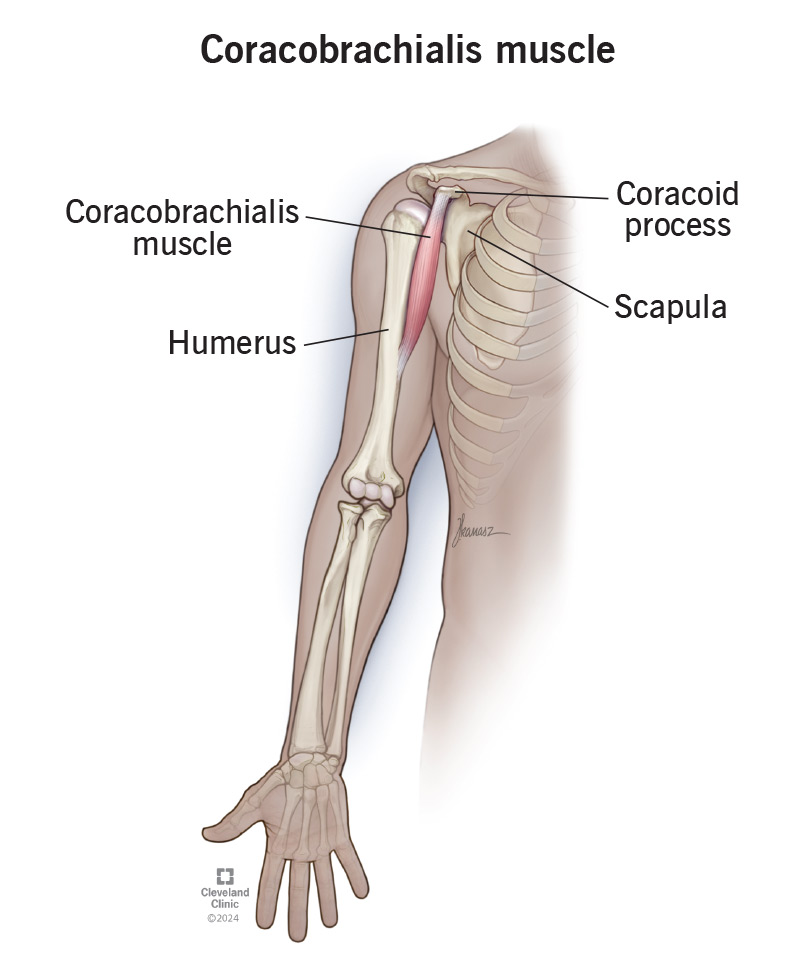Your coracobrachialis muscle attaches to the front of your shoulder joint and your upper arm bone. It plays a supporting role in bending your upper arm and bringing it close to your body. You can strain it if you use it a lot to perform these types of actions, like doing pushups, swinging on gymnast rings or carrying heavy bags at your sides.
Advertisement
Cleveland Clinic is a non-profit academic medical center. Advertising on our site helps support our mission. We do not endorse non-Cleveland Clinic products or services. Policy

Your coracobrachialis is a small muscle at the front and top of your upper arm. It starts from your shoulder joint and inserts into your upper arm bone about halfway down, on the armpit side. This is what its name means: Coraco- refers to your coracoid process, the bony projection on your scapula that serves as the muscle’s attachment site. -Brachialis refers to your upper arm, where the muscle ends.
Advertisement
Cleveland Clinic is a non-profit academic medical center. Advertising on our site helps support our mission. We do not endorse non-Cleveland Clinic products or services. Policy
It’s not one of your most prominent arm muscles, and it doesn’t play a large role in moving your arm. But your coracobrachialis muscle can become tight from certain activities, and it can be a hidden source of shoulder pain or arm pain. The nerve that feeds into it — your musculocutaneous nerve — runs from your shoulder all the way down your arm, and it can refer pain from one area to another along the way.
Functionally, your coracobrachialis isn’t a very significant muscle. But it plays a supporting role in:
If your coracobrachialis muscle were injured, you’d still be able to perform these actions, but they might be more difficult. You might feel some weakness, soreness or instability when using your arm for:
Advertisement
You might see your coracobrachialis muscle if you flex your biceps in the mirror. It’s the slender muscle that crosses from the front of your shoulder joint over the edge of your armpit to your forearm. If you put two fingers on your collarbone and follow it to your shoulder, you’ll find the bump of the coracoid process, where the muscle attaches. Pressure here should return some sensation from the muscle.
From here, the muscle runs down the inside of your upper arm to the midpoint. Your chest muscle (pectoralis major) passes over it, traveling from your chest across the front of your shoulder to attach to your upper arm. Your coracobrachialis lies deeper, tucked in the groove between your biceps and triceps muscles. If you put your fingers in here and squeeze your arm into your side, you might feel it pop out.
Any general muscle disorder or injury can affect your coracobrachialis, though most aren’t likely to. Since it’s not close to the surface, it’s not as exposed to injury as other muscles, and you probably don’t use it as heavily. But athletes and people with jobs that involve repetitive tasks may be more at risk of overusing their coracobrachialis. The most likely conditions to affect your coracobrachialis muscle are:
Soreness in your coracobrachialis muscle may be hard to identify, especially if you’re not familiar with it or its location. Complicating matters, the muscle can refer pain anywhere along the path of your musculocutaneous nerve, from your shoulder down your forearm. So, if you have unexplained shoulder pain or arm pain, you might want to try to find your coracobrachialis muscle and check it for stiffness.
If pressing on the muscle hurts or makes your shoulder or arm pain worse, it’s probably the source of your pain. If you feel a hard knot in the muscle that’s extra sore when you press on it, that’s a myofascial trigger point. Working the knot out will relieve the pain. Symptoms of musculoskeletal nerve entrapment can include numbness on the inside of your forearm or weakness when flexing your elbow.
Advertisement
If you’ve strained your muscle, the best treatment is rest. If your muscle has become stiff and tight, massage might help. Consider visiting a sports medicine physician or a physical therapist for hands-on treatment. If you have myofascial pain, you might benefit from trigger point therapy (myofascial release). If you have symptoms of a pinched musculocutaneous nerve, consult your healthcare provider.
Your coracobrachialis is a small, hidden muscle at the front of your upper arm, close to your armpit. You probably wouldn’t notice it unless you were using it a lot. But if you do a lot of pushups, swinging on rings at the gym or carrying heavy bags with your arms down at your sides, your muscle might start to feel sore and tight. If you have unexplained shoulder pain or arm pain, it could be your coracobrachialis.
Advertisement
Cleveland Clinic’s primary care providers offer lifelong medical care. From sinus infections and high blood pressure to preventive screening, we’re here for you.

Last reviewed on 01/27/2025.
Learn more about the Health Library and our editorial process.